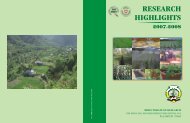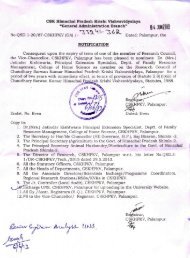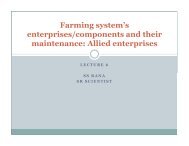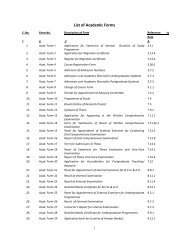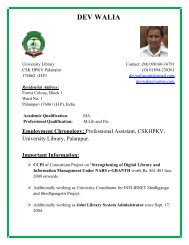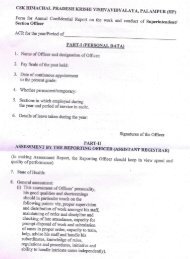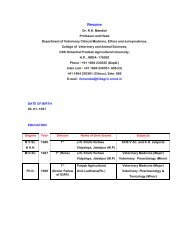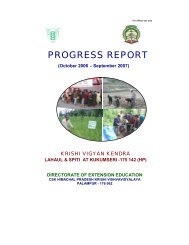animal production - CSK Himachal Pradesh Agricultural University ...
animal production - CSK Himachal Pradesh Agricultural University ...
animal production - CSK Himachal Pradesh Agricultural University ...
Create successful ePaper yourself
Turn your PDF publications into a flip-book with our unique Google optimized e-Paper software.
30 750 32 360 3.5 2.5<br />
35 875 35 420 4.0 2.8<br />
40 1000 40 480 4.5 3.0<br />
45 1125 42 500 5.0 3.5<br />
50 1250 45 540 5.5 3.8<br />
55 1375 50 600 6.0 4.0<br />
60 1450 54 640 6.5 4.5<br />
Feeding schedule for stall-fed sheep<br />
For breeding rams, 50 per cent more nutrients should be given than their maintenance, ration. Similarly, pregnant<br />
sheep should be provided 50% more nutrients than the maintenance needs. Sheep also require extra nutrients to bring<br />
them to flush and therefore, should be provided with 25% more nutrients above the maintenance needs before start of<br />
breeding season.<br />
Sheep are mainly raised for lamb and wool and not for milk <strong>production</strong>. However, high lactation performance is<br />
essential for the nutrient supply of lambs during early stage. This is all the more important if twins are nursed by ewes. It<br />
has been observed that sheep should be fed twice the maintenance requirements to maintain good <strong>production</strong> status during<br />
first 6 weeks of lactation, while the allowance could be reduced to 50% above maintenance, during the remaining period.<br />
They also need additional leguminous fodder, preferably hay. A concentrate mixture similar to one used for dairy <strong>animal</strong>s<br />
may be prepared to feed them when green fodders are not in plenty.<br />
An adult sheep needs about 0.5 kg concentrate mixture and 5 kg green fodder. For sheep, feed ingredients<br />
should be coarsely ground because they chew their feed thoroughly. Before the start of breeding season, feed additional<br />
0.2 kg concentrate or lush green legume fodder. The same amount of additional feed is to be provided during last two<br />
months of pregnancy.<br />
Managing the ewes during gestation<br />
Exercise should be given to the pregnant sheep if they are stallfed. Exercise will help to reduce lambing paralysis<br />
and ease at the time of parturition. The pregnant ewes should be kept under shade during warm weather and the sheep<br />
should be saved from injury from other <strong>animal</strong>s like cattle, hogs etc. and should not be grazed alongwith other <strong>animal</strong>s.<br />
Care of ewes during lambing seasons<br />
The ewes should be separated at the time of lambing. In the ewes that are about to lamb, there will be sinking on<br />
either side of the rumps in front of the hips, the vulva will enlarge, wax will form at the ends of the teats and they will show<br />
the signs of filling. At the time of lambing it will be better to keep the ewes in a separate lambing enclosure. Protection<br />
against inclement weather should be provided, if necessary. Just prior to lambing, the ewes show characteristic vertical<br />
movements of the tail and usually lag behind from the rest of the flock. Ewe scratches the ground with front legs, constantly<br />
changing her position by standing and sitting. The wool should be cut around the teats and the genital organs. Do not<br />
disturb the ewe during first stage of labour. However, if it is not normal, then help of an experienced veterinarian should be<br />
sought to correct the position of the fetus.<br />
Care of the ewes immediately after lambing<br />
The ewe should be kept under observations for some days after lambing. The shepherd should be sure that the<br />
ewe has expelled the afterbirth and that her udder and bowels are in good condition. If the ewe is constipated, a drench<br />
consisting of 125 ml of linseed oil or 85 g of epsom salt, dissolved in luke warm water should be given.<br />
Care of the new born lambs<br />
When the lamb is born, pinch off the umbilical cord about 10 cm. from the body. The naval should be disinfected<br />
with tincture iodine to prevent infection. Be sure that all mucus is removed from the nose and mouth. The lamb should be<br />
placed near the ewe's head. She may rest and clean the lamb. If the ewe owns the lamb, it will be best to leave her alone.<br />
A strong lamb will be on its legs in a few minutes and will usually suckle unassisted. Provide help to the week lambs in<br />
suckling milk. The first step in assisting a weak lamb is to milk a few drops from the ewe's teats to make sure that the milk<br />
channels are open. Place the teat in the lamb’s mouth and squeeze some milk into it.<br />
25



